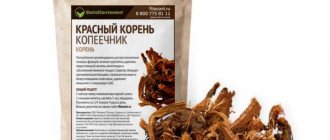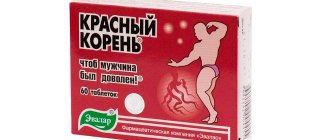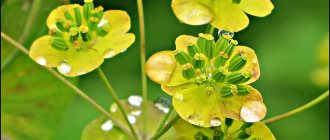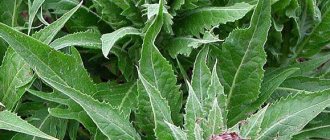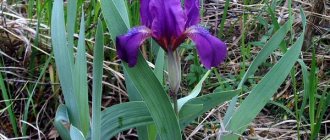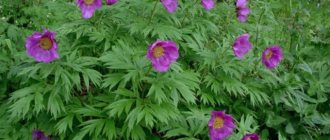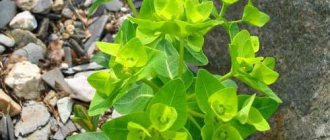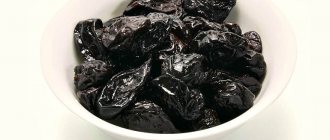The herbaceous plant red root belongs to the genus Kopecica from the legume family. The popular name is kopeck forgotten, also known as bear root. The herb is famous for its unique properties, which are used to treat disorders of the genitourinary system, oncology, anemia, and is used as a tonic and stimulant in folk medicine. Herbal tinctures are used by emperors in China, which confirms its uniqueness.
Descriptions and photos of pennywort
Forgotten kopekweed (red root) is a perennial herb, sometimes appearing at first glance as a low shrub or less commonly a subshrub. Visually, the plant can be described as follows: the stem is strongly pronounced, the flowers are in dense racemes, the leaves are odd-pinnate and the beans are segmented.
The main advantage of the pennyweed is the root, which is hidden underground; it is about 11 m long and about 13 cm thick, as for the color, it is clear from the name. It is rich in a huge amount of oligomeric catechins of a separate condensed type. These are the ones that are worth paying attention to, as they belong to the unique bioflavonoids that give the red root tincture its red color.
You can also come across the name as Bear Root - there are opinions because the bears who eat it like it, and also Squirrel Root - it was called that way because it grows near “squirrels” - accumulations of snow in the mountains.
“Urine is the only pleasure for which you don’t have to pay.” Socrates
Composition and medicinal properties of pennyweed
- Pennywort root is rich in condensed oligomeric catechins, which belong to the category of bioflavonoids. Their amount varies approximately from 10 to 33% of the air-dry mass. That’s why the infusion of kopeck grass turns brown-red.
- Also, the composition of this plant includes: triterpene saponins, xanthone hedysaride, tannins, flavonoids, free amino acids, coumarins.
- The composition of the drug "Alpizarin" includes the herb kopeck, the drug is effective in the treatment of warts and herpes in adults, it has high antiviral activity.
- Kopechnik is an excellent natural remedy for the prevention and treatment of male ailments. This plant stimulates blood circulation, greatly improves the activity of the urinary-excretory system, and helps eliminate congestion in the prostate gland; it is a stimulant of sexual activity for men.
- It is also recommended to use the infusion to normalize the functioning of the gastrointestinal tract; as a rule, it helps treat constipation and liver diseases.
- Particularly effective in cases of difficulty in the functioning of the cardiovascular and respiratory systems.
- It gently stimulates the heart muscle, helps with intense coughs, and helps fight bronchial asthma, tuberculosis, pneumonia and bronchitis.
- The catechins found in the plant distinguish it from other medicinal herbs by their serious P-vitamin level of activity, thanks to which they contribute to the strengthening and regeneration of capillaries, and the activity of antioxidants, which creates the ground for neutralizing free radicals.
- These substances help remove heavy metals from the human body.
- Kopechnik is also used for infertility, uterine bleeding, cancer, and epilepsy.
- Preparations based on pennywort have general strengthening and tonic properties: they help relieve fatigue, restore strength after heavy exertion, and help increase the level of endurance.
Medicinal properties of penny herb
The medicinal properties of pennyweed are influenced by the following components:
- xanthines;
- tannins;
- flavonoids;
- polysaccharides;
- retinol;
- phytoestrogens;
- pectin;
- starch.
Flavonoids, in particular catechins, are characterized by the fact that they help remove harmful substances and heavy metals from the human body. They also strengthen and, most importantly, reincarnate the capillary walls and neutralize free radicals.
Also, the pennycress can also be used as a melliferous, fodder or ornamental plant.
Forgotten pennyweed (Hedysarum neglectum)
The medicinal properties of the forgotten kopek are due to its unique composition. Flavonoids, namely catechins, remove harmful substances and heavy metals from the body, strengthen and restore capillary walls, and neutralize free radicals. They also regulate the activity of smooth muscles of internal organs and blood vessels. Under the influence of flavonoids, internal organs and vessel walls relax, which leads to improved microcirculation and the elimination of spasms. It has been established that the flavonoids of the forgotten pennyweed have a direct effect on the prostate gland, relaxing the smooth muscles of the ducts of the prostate glands. As a result, the outflow of prostatic juice is restored and blood circulation in the tissues improves. Thus, it is considered proven that the forgotten kopeck is very useful for men suffering from prostatitis, and can also be used in the treatment of various tumors, leukemia, fibroids, neurological and cardiovascular pathologies. The coumarins contained in the herb kopeck also have a pronounced muscle relaxant effect. Catechins are complex organic compounds that have a pronounced vasoprotective effect (strengthen blood vessels). Also, catechins are able to bind to heavy metals and free radicals, accelerating their elimination from the body - this explains the antitoxic effect of the forgotten pennyweed. In addition, kopeck naturally accumulates selenium - such an important trace element, without which the human hematopoietic system cannot function normally. Saponins, dissolving in the gastrointestinal tract, form foam that irritates the mucous membrane of the stomach and intestines. Irritation of the receptors of the mucous membrane of the digestive system causes reflex activation of the glands of the bronchi and prostate. As a result, the production of secretions by these glands increases. The local effect of saponins on the mucous membrane of the digestive tract causes an increase in the activity of the epithelium, which in turn increases the absorption capacity of the digestive tract. As a result of a number of experiments, scientists have found that in patients with COPD (chronic obstructive pulmonary disease) and concomitant pathology of the genitourinary system, the use of herbal medicines based on the forgotten kopeck in complex therapy helps to reduce the intensity of cough, reduce the purulence of sputum, improve the psycho-emotional status and blood counts. With chronic prostatitis, patients experience a decrease in pain syndrome, a decrease in the number of dysuric disorders, sexual dysfunctions, and bacteriuria. With concomitant benign prostatic hyperplasia of degrees I and II, dysuric and sexual disorders are less common, and the quality of life improves. The subject of another study was the antibacterial effect of herbal remedies from various types of kopeks on 4 test cultures (P. aeruginosa, E. coli, S. aureus, K. pneumonia). The most pronounced antibacterial activity was detected in extracts obtained from the roots of the forgotten and tea leaves. Forgotten kopeck inhibits the synthesis of dihydrotestosterone (due to the blockade of 5-alpha reductase types I and II) and its fixation to cytosolic receptors, which prevents the penetration of the hormone into the nucleus and leads to a decrease in protein synthesis. This explains the antiandrogenic effect of the plant.
Applications of pennyweed
The main uses of pennyweed, forgotten in medicine, can be attributed to a number of pathologies:
- diseases of the genitourinary system;
- sexual impotence;
- infertility;
- various oncological diseases;
- helps increase male potency;
- stimulates blood circulation and eliminates congestion in the prostate;
- restores energy after hard physical work.
In society, the plant symbolizes the “spirit of water”, and therefore normalizes fluid exchange in the human body. Science explains this by saying that the red root increases diuresis, which has a positive effect on people with kidney diseases, as well as the genitourinary system, and normalizes urine output.
Composition of red root
The healing effect of the red root occurs due to the presence of the following components in the plant:
- xanthone;
- coumarin;
- triterpene saponins;
- catechins;
- flavonoids.
Due to the presence of a large amount of tannins, the plant produces an anti-inflammatory effect.
The above-ground part of the red root consists of various alkaloids, saponins, xanthones, hyperosides and polystachosides, and the leaves of the plant contain ascorbic acid.
The unique composition of tea kopeck allows you to saturate the human body with useful substances: amino acids, microelements, vitamins. Long-term use of products containing red root produces a healing effect on all organs and systems and improves immunity.
Red root herb - for potency
Kenny root is a natural non-hormonal stimulant for increasing potency for men with safe effects. Flavonoids, which are found in the root, have a beneficial effect on the male prostate; when taken, they relax the smooth muscles of the prostate ducts. Which leads to the resumption of the outflow of prostatic juice, after which blood circulation improves.
It is worth paying attention to the correct intake of the plant to increase potency; if you violate the rules of intake, you can get liver, kidney or joint diseases.
The influence of a penny on men
The red root is especially valued among the male population. Sexopathologists and urologists put it on a par with synthetic medications in terms of effectiveness.
Since the product is of plant origin, the treatment result is not achieved so quickly, but its advantage is a stable effect and a minimum of contraindications.
Traditional medicine has long used the red root in the treatment of prostatitis, adenoma, and their consequences. The plant is successfully used for both therapeutic and preventive purposes for:
- Pyelonephritis (kidney infections);
- Urethritis;
- Cystitis;
- Hydrocele of the testicles;
- Pain in the genital area;
- Malignant neoplasms in the genitourinary system;
- Male infertility;
- Low libido (decreased sexual activity);
- Complete or partial loss of sexual function (impotence).
The presence of flavonoids in the red root helps relax the smooth muscles of the prostate ducts. This restores the process of outflow of prostatic secretions and improves blood supply to the organs of the genitourinary system.
The plant activates a man’s sexual capabilities, restores his body after heavy physical exertion, eliminates fluid stagnation in the prostate, and increases blood circulation in the genital area and the entire reproductive system.
Recipes
Medicinal tincture
Chopped root 100 g, season with good vodka - 1 liter, stir, then leave for about 14 days, from time to time you need to stir the medicinal infusion.
Take one teaspoon three times a day, half an hour before meals, if desired, can be diluted in 50 ml of water. This infusion is recommended for:
- tuberculosis;
- inflammation of the bronchial mucosa;
- pneumonia;
- anemia;
- inflammation of the prostate;
- for the treatment of reproductive function;
- for infectious diseases: influenza, ARVI, sinusitis.
Medicinal tea
- Take 10 g. crushed root, add to a mug with boiling water, leave for 30 minutes, and take before meals twice a day.
- Take 30 grams of red root, add 1 liter of boiling water, then infuse, be sure to strain before taking. You can add milk or honey to taste.
Balm
Recommended for prostatitis, adenoma, sexual impotence, diseases of the gastrointestinal tract, neuroses.
You will need 60 grams of ground root and 60 grams of propolis. Add 1 liter of honey to our mixture. alcohol, then mix and shake. Then we let our balm brew for about two weeks in a cold place, after which we must strain.
Dose 25 drops three times a day, before meals. Take for a month, after which you need to take a break for at least two months, then repeat for another month.
Beneficial properties and uses of kopeck root and tincture
Useful properties of pennyweed
The healing properties of pennyweed are due to its unique composition. The plant contains xanthones (up to 1%), tannins, flavonoids, polysaccharides, vitamin A, phytoestrogens, pectin and starch. Flavonoids, namely catechins, remove harmful substances and heavy metals from the body, strengthen and restore capillary walls, and neutralize free radicals. This explains the widespread use of pennywort for the treatment of tumors, leukemia, prostatitis, fibroids, neurological and cardiovascular pathologies.
The ability of drugs based on pennywort to enhance the production and activity of macrophages is also noted, which allows the human body to actively repel attacks by pathogenic microflora and not react to stress. Medicines from this plant also have tonic and immunomodulatory properties.
In addition, kopeck naturally accumulates selenium - such an important trace element, without which the human hematopoietic system cannot function normally. The roots of the plant and its above-ground part are used for medicinal purposes.
The use of penny
Traditional medicine of China and Tibet uses infusions and decoctions of this medicinal herb for the prevention and treatment of colds of viral etiology, chronic lung diseases, atherosclerosis and herpes. Siberian healers use the plant for oncology, anemia, genitourinary diseases, and also as a general tonic and stimulant.
There is information about the possibility of treating latent infections - ureaplasmosis, mycoplasmosis, chlamydia - with pennywort preparations. According to VILAR, they are able to stimulate sexual activity, which is explained by the presence of phytoestrogens in the herb. However, if drugs are used incorrectly, instead of potency, you can develop diseases of the kidneys, liver and joints.
Infusion from the root: 25 g of dry roots must be washed well and poured with a liter of boiling water. The mixture should be infused for at least one hour in a thermos. It is recommended to drink it as tea, 1/3 cup 3 times a day, with the addition of milk and honey. This infusion helps the body cope with many infectious colds (flu, sinusitis, etc.).
Tea penny root
The root of this herb is brown in color, highly branched, up to 1.5 meters long, and has an astringent taste. It has always been used in folk medicine as an effective remedy for the treatment of acute and chronic prostatitis, urethritis, adenoma and other urological diseases. Tea kopeck root is a natural non-hormonal stimulant of sexual activity for men, acting gently and gently. Tinctures and balms are most often made from it, which acquire a beautiful pinkish-red color due to the catechins contained in the root.
Alpine pennywort
This perennial herbaceous plant reaches a height of 1.5 meters, has a thick branched rhizome and numerous erect stems 3–5 mm thick. The inflorescences are represented by long dense racemes with 20–50 flowers. The fruits are appressed-hairy or bare beans. The flowering period of the plant is July-August, the fruits ripen in late August and early September.
The above-ground part of the plant, collected during budding and flowering, is used for medicinal purposes. When preparing raw materials, stems with leaves are cut at a height of 10–20 cm from the ground surface. In medicine, preparations from this herb are used as a sedative and expectorant, and also as an antiviral for herpes.
Tincture of kopeck
To prepare tinctures, not only the roots of the plant, but also its grass can be used.
Recipe 1: fill a half-liter jar 1/2 with fresh grass and 1/3 with dry grass, fill to the top with vodka, leave the mixture for at least 10 days in a dark place, then strain. Dosage: 1 teaspoon of tincture is diluted in 100 ml of water and drunk 3-4 times a day half an hour before meals. The course of treatment is 1 month. It is recommended to conduct 2–4 courses throughout the year.
Recipe 2: pour 50 g of dry crushed roots into a 0.5 liter jar and fill them with 40–50 degree alcohol. The product should be infused for 8–10 days in a dark place at room temperature, after straining, dilute 0.5–1 teaspoon in a glass of warm herbal tea and drink 2–3 times a day 0.5 hours before meals. The last dose of the tincture is recommended at least 3 hours before bedtime, since the root of the plant has a tonic effect. The course of treatment is 1–3 months.
Contraindications of the herb
You should not take it if you have individual intolerance, pregnancy or lactation.
Root-based products are prohibited for children under 13 years of age, as well as for those with increased nervous excitability, grade 3 and 4 hypertension, and after myocardial infarction.
Author: Andrey Candidate of Sciences in Forestry. Author of 3 patents on the care and cultivation of plants at home. Author of more than 30 scientific articles in popular research journals. Just a nature lover.
Application
Medicinal Use in official and folk medicine
The main active ingredient mangiferin has antiviral activity against herpes simplex viruses, chickenpox viruses, cytomegaloviruses and even the immunodeficiency virus, although, of course, it should not be considered as a remedy for AIDS. Pennywort exhibits an inhibitory effect in the early stages of virus development. In addition, it has immunostimulating properties in relation to cellular and humoral immunity, induces the production of interferon gamma in blood cells. Long-term pharmacological studies have shown that mangiferin can be used by both adults and children as an antiviral agent for acute and recurrent forms of herpes simplex genital and extragenital localization, eczema Galoshes, for viral diseases of the mucous membrane and oral cavity, herpes zoster, chickenpox. It is usually used in the form of a pharmaceutical preparation alpizarin (ointment or tablets).
Use at home
You can prepare an infusion from the kopek grass. It is used for herpes simplex. For this, 1 tbsp. pour a spoon (without a slide) of dry raw materials with 1 glass of boiling water and leave for 30 minutes. After this, filter and take V3 glasses 3 times a day. The course of treatment is from 10 to 30 days. If necessary, the course can be repeated after 20-30 days. It is better to time treatment to coincide with periods of activation of the virus, which begins to rage in the fall and at the end of winter - in the spring. Attention! Kopechnik is contraindicated for use during pregnancy.
